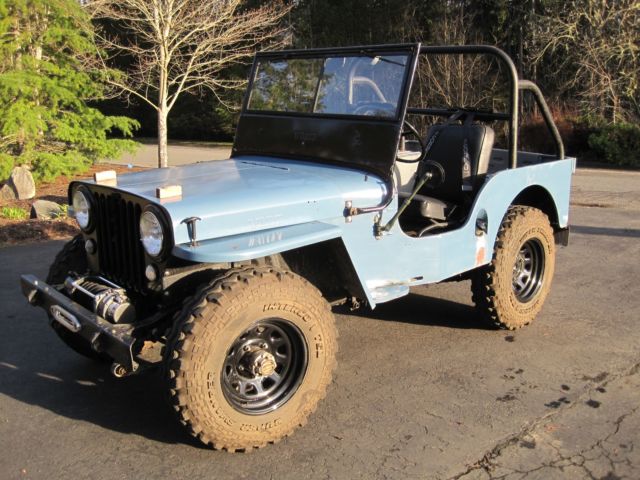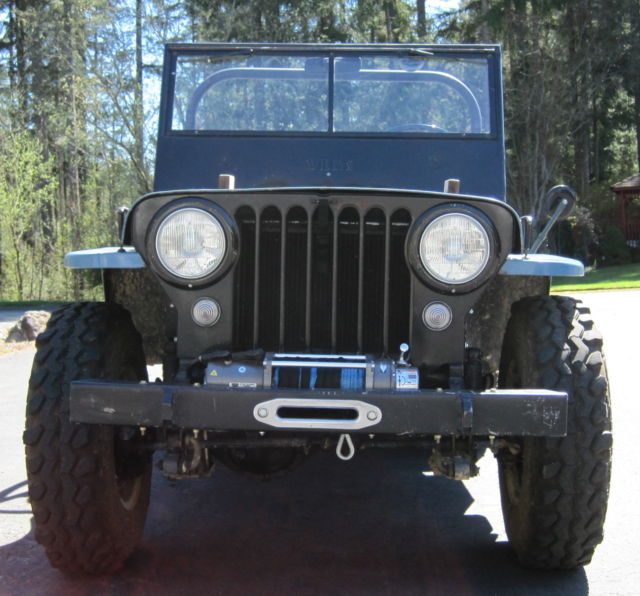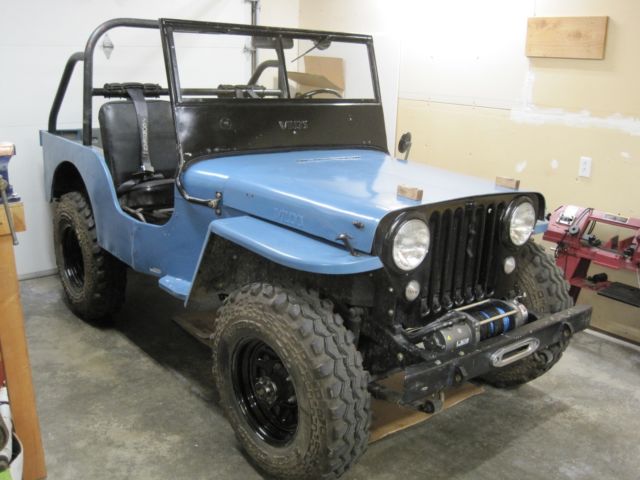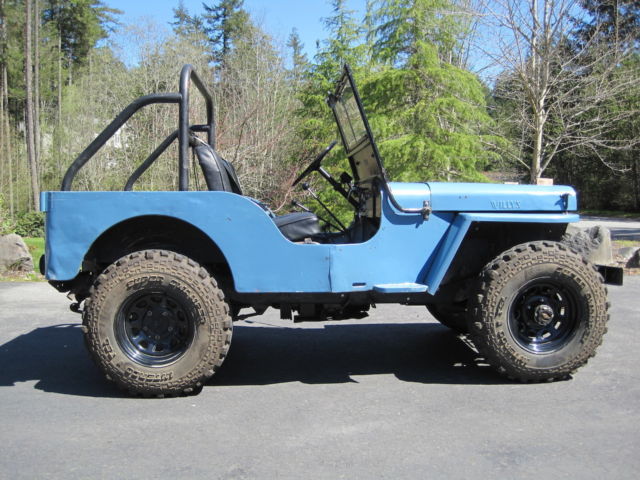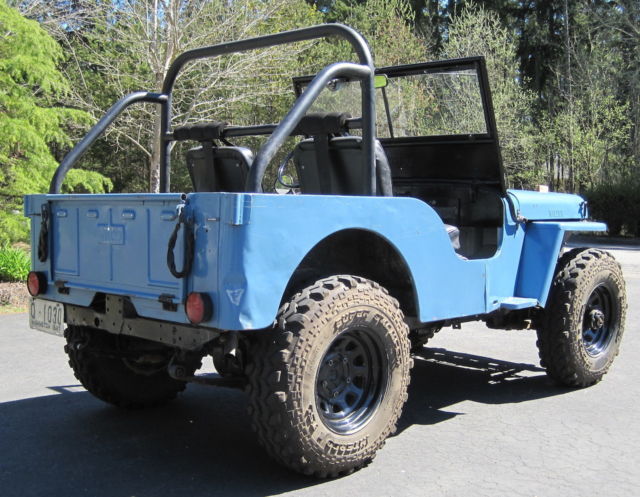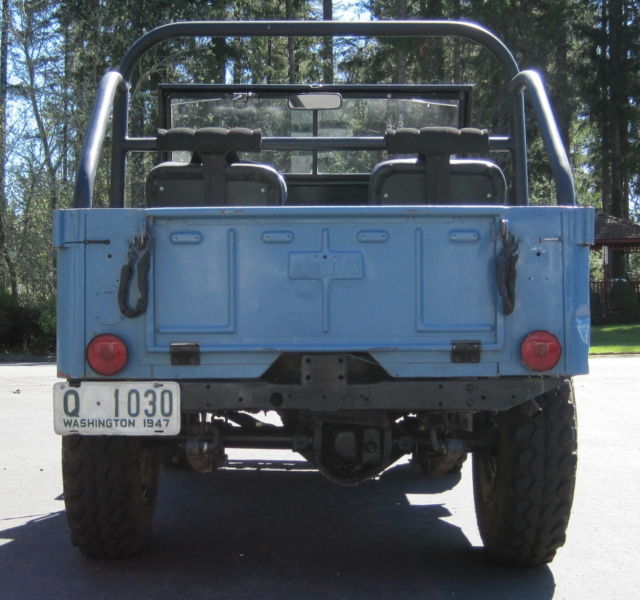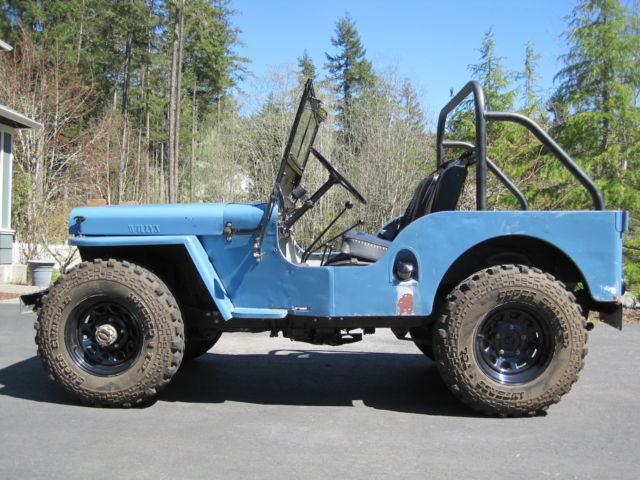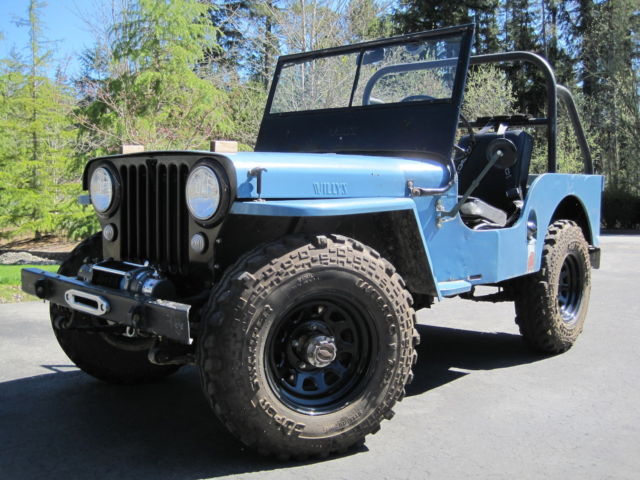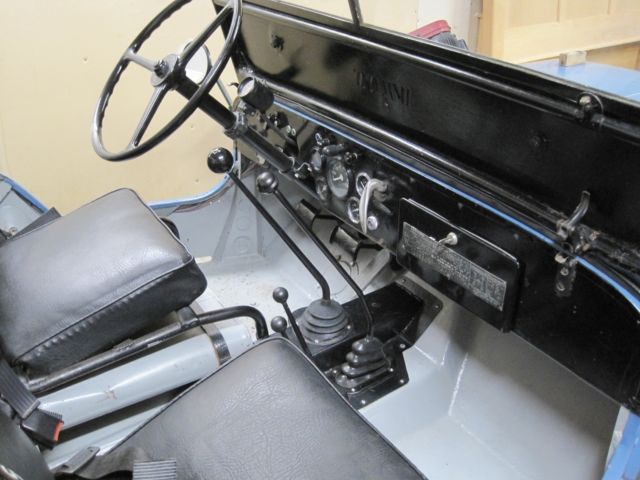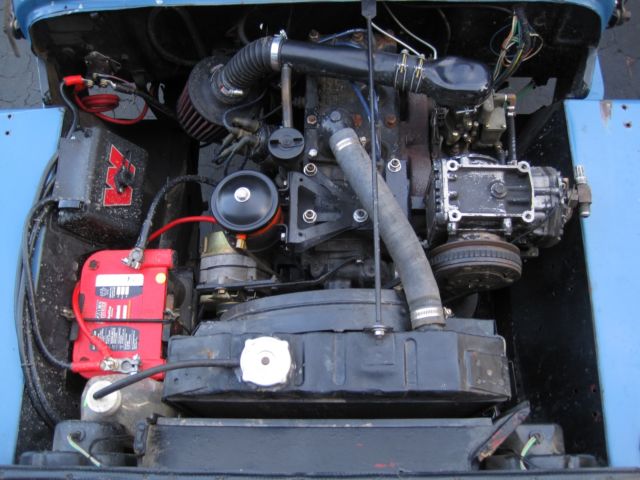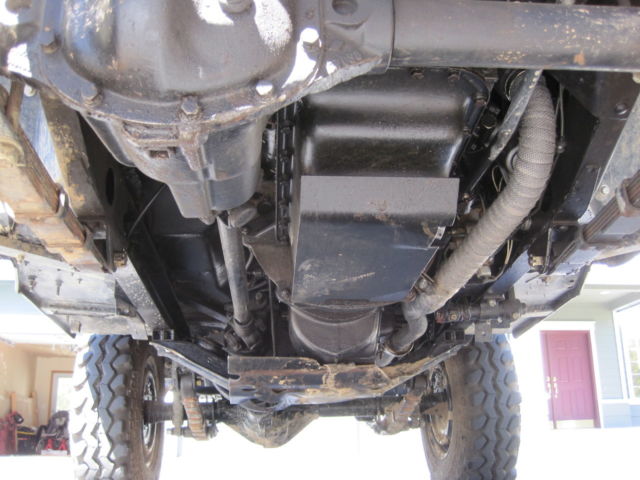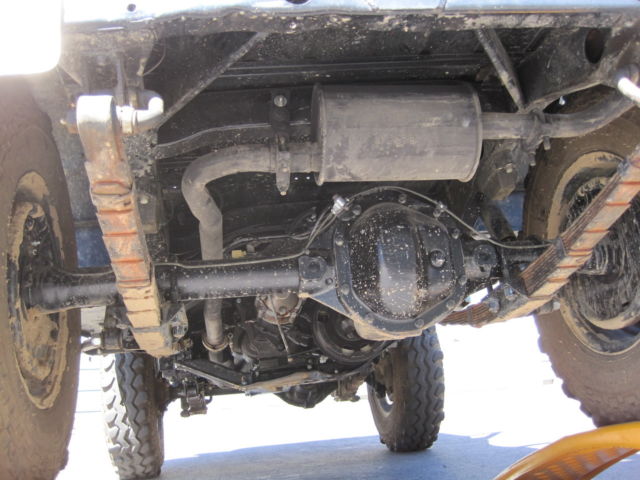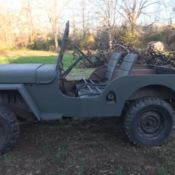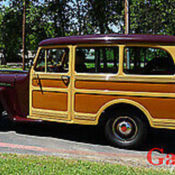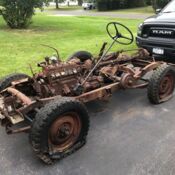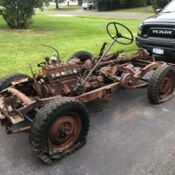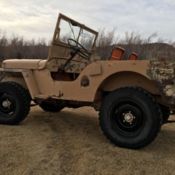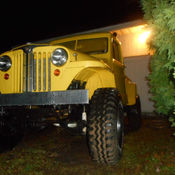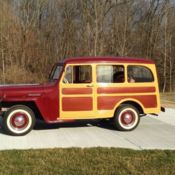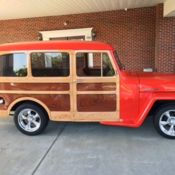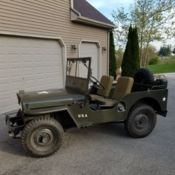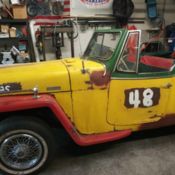1947 Willys Overland Jeep CJ-2A resto-mod
| Condition: | Used |
| Make: | Willys |
| Model: | CJ-2a |
| Type: | Jeep |
| Year: | 1947 |
| Mileage: | 84,981 |
| VIN: | JU100826 |
| Color: | Blue |
| Engine: | 134 L4 |
| Cylinders: | 4 |
| Fuel: | Gasoline |
| Transmission: | Manual |
| Drive type: | 4WD |
| Interior color: | Grey |
| Drive side: | Left-hand drive |
| Safety: | 4 point seatbelts |
| Vehicle Title: | Clear |
| Item location: | Bremerton, Washington, United States |
| Extras |
|
T98 4 speed, Warn Overdrive, Locking Differential, On Board Air, Disc Brakes, 4-Wheel Drive |
| Listed by | Private seller |
Description of 1947 Willys CJ-2a |
|
For sale is my wonderful 1947 Willys Overland "Jeep" CJ-2A It's fun to drive, fun to take on trails, everything works (and works properly), and it has been lovingly cared for. I purchased it back in 2006 as a complete and nice driver from a fellow who had owned it about 20 years. He bought it used in San Diego and later moved it to Port Angeles, Washington. After I purchased it I decided to embark on a full ground up/frame up chassis and drivetrain restoration, which I completed Spring 2007. (It currently has about 3600 miles on the restoration). For the most part it is an original vehicle, with a few modifications to make it more practical and more enjoyable to drive. Highlights as follows:
When I rebuilt this Jeep, I did it with the intention of keeping it forever. Every single component was carefully cleaned, inspected, repaired or replaced as needed. The modifications from stock werecarefullychosen to be somewhat period correct and to enhance and improve the Jeep while maintaining it's original character. The non-stock parts that I did use are almost entirely from newer model jeeps and have readilyavailable repair parts should the need arise in the future. There are lots of extras not mentioned above, contact me for full details or to arrange a viewing/test drive. I am willing to assist with pickup and delivery, potentially I could trailer tow it to you, please contact me for details. I have a detailed build thread listed on a jeep forum, please contact me for the link. Also note I have this vehicle listed for sale locally and reserve the right to terminate theauctionearly. On Apr-23-17 at 17:25:02 PDT, seller added the following information:-------Going item by item from roughly front to back, here is the current condition and what has been done. Unless otherwise mentioned, the rebuild/restoration of each part occurred during the initial 2006-2007 restoration. Almost everything was taken to bare metal (via wire wheel or sand blast) and then prepped and painted with the POR-15 4 step clean and paint process, unless otherwise noted. Frame: Frame was stripped to bare metal and painted with POR-15 process including cleaner, metal prep (zinc phosphate coating), POR-15 black base/rust preventative coating and POR-15 black topcoat. Condition of frame was/is excellent with no cracks or other signs of damage. There were a couple of small (previously) treated rust holes in the battery tray. The frame is a little bit dirty right now, but otherwise it appears to be in the same condition as when I repainted it. Front bumper: Good condition, couple minor dents, good coat of black paint. Lightly modified to accept winch fairlead. Winch mount system is in great condition and is a bolted system that ties in between the bumper and chassis. Front steering bell crank: Minor play in system. This has been fully rebuilt with new bearings and pin. The relay rod has been fully rebuilt with new kits on both ends. All tie rod ends have been replaced. Steering box: Original “Ross” type. Fully rebuilt with new bearings/bushings/seals throughout. New sector shaft (replaced approximately 2013). Minimal play and friction, it works really well for a stock system! I have had some trouble with this leaking which lead to the second rebuild with a new sector shaft. I believe it is currently leak free, but have not verified the fluid level recently. I do have a used tight steer system for it, but I misplaced it during my last move. If I can find it for you it will be included in the sale. I replaced the steering tube during the rebuild (the original was bent) and the steering wheel is in excellent condition, most likely a replacement the previous owner added. Brake Master Cylinder: As noted, this is a replacement dual circuit system, I think similar to that used in approximately 1971. This was a new unit/kit purchased from ATV Mfg (AKA Herm the Overdrive Guy). I did have to remove some of the original mounting bracketry (for the stock system), but I do have it and will include it with the sale. Coming off the MC are full new hard lines with residual valves running to new soft lines at the axles. Radiator: I had this re-cored with a new brass/copper 3 row core by a local fellow that specializes in this type of work. I run a 10psi recovery type cap. The recovery bottle is just a water jug, but it fits and works properly. Engine: Full rebuild as mentioned previously. Additional notes: During the rebuild process a small (2-3”) crack was found directly above the distributor boss. Apparently this isn’t that unusual. The crack was repaired by the engine shop with “Lock N Stitch” block repair system. While the repair is all but invisible, I have had very minor weeping as noted by bubbled paint in this area. I have never seen coolant actually leaking from the repair, but as I said I have seen the original paint bubble here and I found evidence (rust marks, staining) that the water had dribbled down to the distributor and down the distributor shaft and into the engine. When I first found this (a little coolant in the oil) I about blew a gasket of my own! I have also witnessed a little coolant migration out of the head studs, although I did apply a high quality thread sealant to all studs during assembly. After consulting the machine shop, they recommended I put a block seal type treatment in the cooling system and I added an o-ring to the top of the distributor. I sanded down and repainted the repaired area. I have not seen any symptoms in this area since. The motor runs good. It does have a slight lope at idle, which I attribute to the Custom Clifford camshaft. This cam was designed to improve power from idle to redline; the motor makes decent power and has good low end grunt; it’s the strongest L134 I have driven, but it is still a mostly stock L134. It prefers to cruise at 45-50mph but can and will pull well over 60mph in the right conditions. I’ve had it to a GPS verified 68 mph on the highway in slight downhill/down wind conditions, but I’ve never really tried to find out how fast it will possibly go. With the overdrive, it is not gearing limited but power limited as far as top speed and highway cruising is concerned. I’ve tried multiple carburetor systems on this engine. I currently have a very carefully tuned and rebuilt original type Carter WO (The Jeep came to me with a Carter WO in a box and a second NOS original Carter WO installed that the previous owner had bought years ago). I took both carburetors completely apart, selected the best parts from both and combined them with a new rebuild kit. I carefully worked my way through every part and measured every orifice and metering rod carefully. Although they were all supposed to be the same sizes, there were differences so I then choose the best combination of parts to get the mixture as close to ideal as I could. Granted this is 1940’s technology so I could only do so much, but it does seem to stay around 12.5-14.5:1 under load and it does work fine. I do get a fair amount of evaporation (off gassing) once I park the jeep after driving, which I have not figured out. It may just be a trait of this carburetor design, which is vented to atmosphere external to the intake. Going back from the engine, it received a new clutch system and a fresh ring (starter gear) on a resurfaced flywheel. The T98 4 speed manual was fully rebuilt and installed within the last 500 miles (originally I had a modified/regeared T90 three speed transmission). I have not replaced the fluid since initial installation but it is probably time to do so. The T98 conversion was done using all factory CJ-5 parts including the bellhousing adapter, t-case adapter and transmission crossmember. I did have to notch a small part of the tub around the shifter tower assembly and I built a new (custom) cover plate with new boots for the transmission, t-case and overdrive shifters and topped off with a custom T98 shift knob with it’s unique shift pattern engraved. This transmission works perfectly, shifts great and never pops out of gear like my original T90 did. The shifter cane (lever) has a bit of wear around the locating pin at the base, so occasionally I’ve had it swing loose but it pops right back into position. It’s more comical than anything. (To be clear, sometimes when you go right and forward to shift into Reverse the pin pops out of the locating groove, allowing the shift cane to rotate- if you rotate it back where it should be everything goes back to normal, and can be done with a flick of your wrist). The T98 does have some gear noise and whine in lower gears and it is amplified in certain conditions by what I believe is some contact between something in the drivetrain and the body. I have not found the source of this contact. Suffice to say the T98 is a large HD truck transmission and it is a tight fit in the CJ-2a, but it does fit. I did use the ‘factory’ inspired drop mounts for the crossmember under the frame, basically, there is a 1” spacer block between the crossmember and frame just like the factory CJ-5 used, only mine is metal, not wood! The transfer case was fully rebuilt in 2006. I had the bare metal parts hot tanked by the machine shop that rebuilt the engine, and then painted them with the POR-15 system. The actual housing is an F-script (Ford) t-case from a GPW, but has been bored out for the 1.125” idler shaft and system and runs full original CJ-2a type “26 tooth input” type 2.43:1 gears. I used a (expensive) special hardened shaft when I rebuilt the transfer case, as this is known wear point. I also modified the shift pills so that in additional to the stock options, you can shift into 2wd-low if desired. It shifts perfectly and I’ve never had it pop out of gear. I suspect the original case cracked at some point and was simply replaced with the GPW unit, using all of the CJ-2a internals and external components. I’ve had the output yokes out a couple of times to re-seal the yokes to try to minimize leaks. It is currently not leaking, but I believe the nature of this t-case is to leak, so no guarantees it will continue to not leak in your garage! Behind the t-case is a Warn Overdrive. I purchased this unit used from a friend and then sent it off to ATV MFG (“Herm the Overdrive Guy”) for a complete rebuild. He replaced all the wear items, synchros bearings and anything else that wasn’t up to his standards. It shifts flawlessly and is truly a joy to shift. One of the wonderful features of this overdrive is the ability to split gears. For example when climbing a steep hill I can shift from 3rd to 3rd OD, then grab both shifters and pull back into 4th direct, and then once it flattens out, you can go into 4th OD. Behind the t-case is a stock E-brake that worked very well with the stock T90. The T98 and crossmember system doesn’t work ideally with the factory cable, so there is some binding. It still works OK but I’m not entirely happy with routing and connection of the e-brake cable. Somewhat related, I did replace the speedometer cable with a longer type and that all works correctly. Connecting the t-case to the axles are rebuilt (lengthened/shortened and balanced) shafts with new Spicer U-joints. Going forward to the front axle: The front axle is a stock Dana 25 with stock 5.38 gears. I completely dissembled, stripped, cleaned and reassembled this unit. I replaced the outer wheel bearings and all seals. I replaced all the trunion/kingpin bearings and re-shimmed to factory spec. The gears and pinion/carrier bearings all looked great. I changed to a newer style (thrust type) bushing in the spindle to allow installation of Warn hubs that I rebuilt with new roller bearings. I replaced the spindle bolts with longer grade 8 units. Years after doing this I read about a possible weak area here and purchased new button head high strength bolts and a counterbore tool to install them from the inside of the knuckle. I have not done this but these parts are included. The shafts are stock type but I do have a set of modern (factory) U-joint type shafts that are included in the sale. The drum brakes have been replaced with a combination of parts replicating the system used on a 1977 CJ-5, utilizing caliper mounts from a full size jeep and new calipers, rotors and studs for a 1977 CJ-5. In the process of installing the studs I accidentally cracked a couple of the through hole in the rotor (crack extends about ½” long from the stud hole to the ID of the rotor). I have a second pair of new rotors included that I have not replaced these with and in ten years of running these brakes I have not had any issues. Going to the rear of the Jeep, the rear axle is as follows: It started out as very desirable 1971 CJ-5 Dana 44. This special axle is the same width and has the same offset as the factory type D41 axle the CJ-2a originally came with. I rebuilt it with new EVERYTHING. I had the housing hot tanked by my engine machine shop. I bought new Dana/Spicer 5.38 gears and mounted them on a new E-locker differential. I went through about 10 iterations to perfect the gear setup. I have photos of the gear pattern if you would like to see them. This was installed with a new install kit with all new bearings, seals and a new yoke and I followed factory procedure with a case spreader to ensure the carrier preload is correct. The shafts were cleaned and have new bearings and seals. The brakes on it were replaced with the largest of the 1977 CJ-5 type; so all replacement parts for the brakes are simply 1977 CJ-5. All of the axle parts are simply 1971 CJ-5, which other than shaft length is common from 1971 to 1975 CJ-5 and probably shared with some jeepster, DJ and full size jeep axles. Finishing the axle off I install a new Dana/Spicer HD (front type) differential cover with a Lube Locker gasket and fabricated high clearance u-bolt plates with new custom u-bolts. The last drivetrain related component I can think of is the exhaust system. When I completed the restoration I had a local exhaust shop build a system from the manifold to tailpipe. I wasn’t very happy with the muffler, so I replaced that with a good factory replacement muffler and tailpipe section. When I installed the T98 I was forced to redo the forward section of the exhaust to clear the new transmission. This was done using mandrel bends and a stainless isolator, fully welded with a V-band flange in the middle and then wrapped with a thermal heat wrap. Also as noted above, I added a wideband oxygen sensor and gauge to aid carburetor tuning. I think that covers the majority of the work done on the chassis. The current condition is still very good. After ten years it is a little bit dirty and oily/greasy in places but overall I think it’s excellent. Moving on to the body. As mentioned above the entire electrical is new and replaced during the restoration. I used a universal automotive wire harness and fuse block. I’m not very happy with the mounting system for the fuse block (there was none) and I just have it zip tied up under the dash. There were a lot of extra (unused) circuits, which for the time being I coiled the wire and zip tied it up under the dash. I figure it’s easy to remove but hard to put these wires back in. A nice benefit of this particular wiring harness is that every wire is labeled down the entire length of the wire. Most connections were soldered and the ones that were not soldered were connected with a good professional type crimp and heat shrink system I purchased from Del City. In addition to all the 12V conversion stuff (such as all new bulbs, the rebuilt starter, a 1 wire 140A alternator and H4 headlights) it also has functional turn signals using a three-position switch on the dash. Wiring is in place for a hazard light but I have not hooked up a dash switch for it. Also I kept both the stock style foot starter button (which is completely functional) but also wired in a relay system from the key so you can start it via the key or foot switch. The last major item is the body. As I purchased the Jeep in 2006, the body was in good condition, so I haven’t done much to it, but here is what I know: I believe it was repainted in the late 1980’s or early 1990’s (the previous owner indicated it was painted prior to his ownership). It was originally Luzon Red (which is a dark/medium red color). As I purchased it the underside was almost entirely red, the inside grey and the exterior blue as it is now. With the body off the chassis I wire wheeled any loose rust on the underside (which was pretty much limited to the hat channels), treated with POR-15 and top coated with a black paint. The hat channels have rust exterior to the body mount; in total there are four sections each less than a foot long that should be repaired if you want it “right”. I believe I stopped the rust, but there are open holes in the bottom of the hat channel. I have had zero issues from this. There is some indication of a bit of bondo in the bottom edge of the driver and passenger rocker directly above the step. Right above the step on the drive side is a hole about 3/8” diameter in the paint that seems to go into this repair but does not go through to the interior. There are a couple tiny spots of rust forming a line near the driver side tail light. Some of the paint has flaked off the passenger step. There are a couple of small dents, in particular the most noticeable in the bottom of the rear passenger corner where I bumped my pickup truck one day when I was trying to maneuver it out of it’s very tight parking space. The floor inside the passenger side tool box is solid. The metal is somewhat bumpy and rough to the touch but it’s solid. I bring this up, as it’s a typical rust zone for these jeeps. There are three small patches bolted on the floor (one on the driver side and two on the passenger side) that don’t appear to be covering up anything other than a few drilled holes on the floor. I have not removed these to investigate. The rear bed area is in great shape. The windshield assembly could use some work. There is a stress crack at the bottom left and right side of the frame that should be repaired for a nice complete restoration. Someone has removed the tilt window features. I have (included) a complete second CJ-2a frame that could be scavenged for parts to add back in the tilt function. I also have a complete CJ-3a windshield assembly included that is in very nice condition that I was planning to use instead just as a personal (stylistic) preference. The CJ-3a frame does need new glass, but is otherwise complete. I also have a new cowl gasket for it, included. I have installed a complete and functional hand wiper on the passenger side and vacuum wiper on the driver side. I never was able to get the vacuum wiper to work satisfactorily, so I have included an electric wiper motor. There is a manual override lever on the driver side that works just fine. As you may notice in the photos, someone has retrofitted a CJ-5 type glove box in the dash. The previous owner said there was a large hole there where someone had installed a stereo so he installed the glove box to clean up the area. It works great and I think it looks like it should be there. The most noticeable blemish on the body is below the gas filler. When I purchased the jeep it leaked gas whenever full and taking a right hand turn. This over time wore down the blue paint exposing the original red paint in this area. Years ago I finally located a gas cap that does not leak one drop. The source of the problem is solved but I have not attempted to touch up this area, though I think it would be a pretty easy job to do so. Speaking of the gas tank: When I installed the T98 I had to redo some of the gas line. I attempted to use hard line from the gas tank to the motor mount, similar to factory. I miss measured something and had to make a short connection from the tank to the hard line with some flex line. I’m not happy with the way that turned out and it is closer to the exhaust system than I would like, but I have not had any issues with it. The gauges in the dash are mostly stock (possibly original). I replaced the ammeter with a stock looking volt meter. I put a 6volt converter on the fuel gauge and replaced the fuel sender on the gas tank and it works pretty well. I believe oil pressure and temp and speedometer are factory type and all work well. The speedometer accuracy isn’t perfectly linear, but at 50-60mph it’s very close to actual speed and it’s fairly stable (the needle bounces a bit, but not too bad). I think that pretty much covers everything. Please contact me if you have any questions or want clarification on anything. Thank you for your time. |
 Home
Home Contact us
Contact us NEWEST CARS
NEWEST CARS SELL YOUR CAR
SELL YOUR CAR FAQ
FAQ